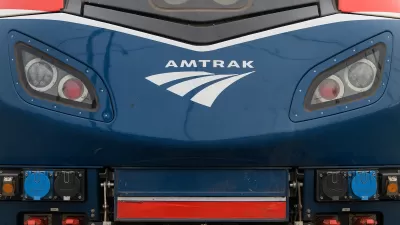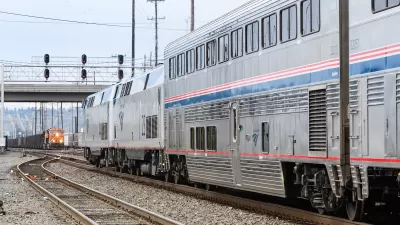An FRA study shows how new Amtrak lines could connect tens of millions more Americans to rail travel.

In a piece for Fast Company, Kristin Toussaint describes how 15 proposed new Amtrak routes could unlock rail travel for 39 million more Americans and serve over 60 new metro areas, as indicated in a map from the Federal Railroad Administration.
“With those rail lines, previously stranded regions of the country are suddenly connected with bright lines representing passenger rail. They would make the country’s rail network considerably fuller and would bring rail service to all of the lower 48 states,” Toussaint adds. “Less than 10% of riders on Amtrak’s current long-distance routes ride from end-to-end, the study notes, but what these routes do is connect people to all the urban and rural places in between.”
The study was the result of a directive that was part of the 2021 Bipartisan Infrastructure Law and was delivered to Congress this week. Public comments submitted as part of the study indicate strong public support for more intercity rail service. As Toussaint notes, “Amtrak itself saw record ridership in 2024, with new routes quickly surpassing expectations.”
Implementing all these new routes would take significant federal investment and planning. According to the study, “there is no sustained financial support or program to construct or operate the selected preferred route options.”
FULL STORY: If the government funded these Amtrak routes, 39 million more people would have rail access

Alabama: Trump Terminates Settlements for Black Communities Harmed By Raw Sewage
Trump deemed the landmark civil rights agreement “illegal DEI and environmental justice policy.”

Planetizen Federal Action Tracker
A weekly monitor of how Trump’s orders and actions are impacting planners and planning in America.

The 120 Year Old Tiny Home Villages That Sheltered San Francisco’s Earthquake Refugees
More than a century ago, San Francisco mobilized to house thousands of residents displaced by the 1906 earthquake. Could their strategy offer a model for the present?

LA’s Tree Emergency Goes Beyond Vandalism
After a vandal destroyed dozens of downtown LA trees, Mayor Karen Bass vowed to replace them. Days later, she slashed the city’s tree budget.

Sacramento Leads Nation With Bus-Mounted Bike Lane Enforcement Cameras
The city is the first to use its bus-mounted traffic enforcement system to cite drivers who park or drive in bike lanes.

Seattle Voters Approve Social Housing Referendum
Voters approved a corporate tax to fund the city’s housing authority despite an opposition campaign funded by Amazon and Microsoft.
Urban Design for Planners 1: Software Tools
This six-course series explores essential urban design concepts using open source software and equips planners with the tools they need to participate fully in the urban design process.
Planning for Universal Design
Learn the tools for implementing Universal Design in planning regulations.
Ada County Highway District
Clanton & Associates, Inc.
Jessamine County Fiscal Court
Institute for Housing and Urban Development Studies (IHS)
City of Grandview
Harvard GSD Executive Education
Toledo-Lucas County Plan Commissions
Salt Lake City
NYU Wagner Graduate School of Public Service





























